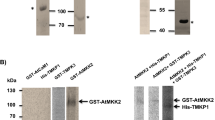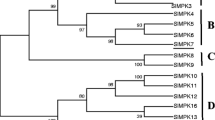Abstract
Salt stress inhibits plant growth and development and plants activate kinase-dependent survival pathways in response to salt stress. However, the role of soybean mitogenactivated protein kinases (MAPKs) in salt stress response has yet to be characterized. In this study, we found that salt stress activates Glycine max MAP kinase 1 (GMK1), a soybean MAPK. The activity of GMK1 induced with increasing salt concentrations, up to 300 mM NaCl, after 5 min of the treatment and was regulated by post-translational modification. We found that mastoparan, a heteromeric G-protein activator, also activated GMK1, and that n-butanol, a phospholipase D inhibitor, and neomycin, a phospholipase C inhibitor, inhibited its activity. Moreover, GMK1 activity was reduced by suramin, a heteromeric G-protein inhibitor, and by two inhibitors of phosphatidic acid (PA) generation after 5 min of 300 mM NaCl treatment. Endogenous PA levels were highest 5 min after induction of salt stress, and exogenous PA directly activated GMK1. From these data, we propose that salt stress signaling is transduced from heteromeric G-protein to GMK1 via phospholipases in the early stages of the response to salt stress in soybean.
Similar content being viewed by others
References
Anstatt C, Tenhaken R (2003) A mitogen-activated-protein kinase from soybean is activated by a pathogen and novel functional analogs of salicylic acid. Plant Physiol Bioch 41:929–934
Balestrasse KB, Zilli CG, Tomaro ML (2008) Signal transduction pathways and haem oxygenase induction in soybean leaves subjected to salt stress. Redox Rep 13:255–262
Bargmann BO, Laxalt AM, ter Riet B, van Schooten B, Merquiol E, Testerink C, Haring MA, Bartels D, Munnik T (2009) Multiple PLDs required for high salinity and water deficit tolerance in plants. Plant Cell Physiol 50:78–89
Broughton WJ, Dilworth MJ (1971) Control of leghaemoglobin synthesis in snake beans. Biochem J 125:1075–1080
Daxberger A, Nemak A, Mithofer A, Fliegmann J, Ligterink W, Hirt H, Ebel J (2007) Activation of members of a MAPK module in beta-glucan elicitor-mediated non-host resistance of soybean. Planta 225:1559–1571
Dhonukshe P, Laxalt AM, Goedhart J, Gadella TWJ, Munnik T (2003) Phospholipase D activation correlates with microtubule reorganization in living plant cells. Plant Cell 15:2666–2679
Higashijima T, Uzu S, Nakajima T, Ross EM (1988) Mastoparan, a peptide toxin from wasp venom, mimics receptors by activating GTP-binding regulatory proteins (G-proteins). J Biol Chem 263:6491–6494
Ichimura K, Mizoguchi T, Yoshida R, Yuasa T, Shinozaki K (2000) Various abiotic stresses rapidly activate Arabidopsis MAP kinases ATMPK4 and ATMPK6. Plant J 24:655–665
Jonak C, Kiegerl S, Ligterink W, Barker PJ, Huskisson NS, Hirt H (1996) Stress signaling in plants: a mitogen-activated protein kinase pathway is activated by cold and drought. Proc Natl Acad Sci USA 93:11274–11279
Lee H, Kim J, Im JH, Kim HB, Oh CJ, An CS (2008) Mitogenactivated protein kinase is involved in the symbiotic interaction between Bradyrhizobium japonicum USDA110 and soybean. J Plant Biol 51:291–296
Lee S, Hirt H, Lee Y (2001) Phosphatidic acid activates a woundactivated MAPK in Glycine max. Plant J 26:479–486
Legendre L, Yueh YG, Crain R, Haddock N, Heinstein PF, Low PS (1993) Phospholipase C activation during elicitation of the oxidative burst in cultured plant cells. J Biol Chem 268:24559–24563
Lieberherr D, Thao NP, Nakashima A, Umemura K, Kawasaki T, Shimamoto K (2005) A sphingolipid elicitor-inducible mitogenactivated protein kinase is regulated by the small GTPase OsRac1 and heterotrimeric G-protein in rice. Plant Physiol 138:1644–1652
Liu JZ, Horstman HD, Braun E, Graham MA, Zhang C, Navarre D, Qiu WL, Lee Y, Nettleton D, Hill JH, Whitham SA (2011) Soybean homologs of MPK4 negatively regulate defense responses and positively regulate growth and development. Plant Physiol 157:1363–1378
Miles GP, Samuel MA, Ellis BE (2002) Suramin inhibits oxidant signalling in tobacco suspension-cultured cells. Plant Cell Environ 25:521–527
Miles GP, Samuel MA, Jones AM, Ellis BE (2004) Mastoparan rapidly activates plant MAP kinase signaling independent of heterotrimeric G proteins. Plant Physiol 134:1332–1336
Munnik T (2001) Phosphatidic acid: an emerging plant lipid second messenger. Trends Plant Sci 6:227–233
Munnik T, Ligterink W, Meskiene I, Calderini O, Beyerly J, Musgrave A, Hirt H (1999) Distinct osmo-sensing protein kinase pathways are involved in signalling moderate and severe hyper-osmotic stress. Plant J 20:381–388
Munnik T, Meijer HJG, ter Riet B, Hirt H, Frank W, Bartels D, Musgrave A (2000) Hyperosmotic stress stimulates phospholipase D activity and elevates the levels of phosphatidic acid and diacylglycerol pyrophosphate. Plant J 22:147–154
Munns R, Tester M (2008) Mechanisms of salinity tolerance. Annu Rev Plant Biol 59:651–681
Olivier S, Formento P, Fischel JL, Etienne MC, Milano G (1990) Epidermal growth-factor receptor expression and suramin cytotoxicity in vitro. Eur J Cancer 26:867–871
Pingret JL, Journet EP, Barker DG (1998) Rhizobium nod factor signaling. Evidence for a G protein-mediated transduction mechanism. Plant Cell 10:659–672
Ross EM, Higashijima T (1994) Regulation of G-protein activation by mastoparans and other cationic peptides. Methods Enzymol 237:26–37
Seo S, Okamoto M, Seto H, Ishizuka K, Sano H, Ohashi Y (1995) Tobacco MAP kinase: a possible mediator in wound signal transduction pathways. Science 270:1988–1992
Sheen J (1996) Ca2+-dependent protein kinases and stress signal transduction in plants. Science 274:1900–1902
Sun J, Miwa H, Downie JA, Oldroyd GED (2007) Mastoparan activates calcium spiking analogous to nod factor-induced responses in Medicago truncatula root hair cells. Plant Physiol 144:695–702
Taylor AT, Kim J, Low PS (2001) Involvement of mitogen-activated protein kinase activation in the signal-transduction pathways of the soya bean oxidative burst. Biochem J 355:795–803
Ullah H, Chen JG, Temple B, Boyes DC, Alonso JM, Davis KR, Ecker JR, Jones AM (2003) The beta-subunit of the Arabidopsis G protein negatively regulates auxin-induced cell division and affects multiple developmental processes. Plant Cell 15:393–409
Welti R, Li WQ, Li MY, Sang YM, Biesiada H, Zhou HE, Rajashekar CB, Williams TD, Wang XM (2002) Profiling membrane lipids in plant stress responses — Role of phospholipase D alpha in freezing-induced lipid changes in Arabidopsis. J Biol Chem 277:31994–32002
Yamagata H, Saka K, Tanaka T, Aizono Y (2001) Light activates a 46-kDa MAP kinase-like protein kinase in soybean cell culture. FEBS Lett 494:24–29
Yamamizo C, Kuchimura K, Kobayashi A, Katou S, Kawakita K, Jones JDG, Doke N, Yoshioka H (2006) Rewiring mitogenactivated protein kinase cascade by positive feedback confers potato blight resistance. Plant Physiol 140:681–692
Yu L, Nie J, Cao C, Jin Y, Yan M, Wang F, Liu J, Xiao Y, Liang Y, Zhang W (2010) Phosphatidic acid mediates salt stress response by regulation of MPK6 in Arabidopsis thaliana. New Phytol 188:762–773
Zhang AY, Jiang MY, Zhang JH, Tan MP, Hu XL (2006) Mitogenactivated protein kinase is involved in abscisic acid-induced antioxidant defense and acts downstream of reactive oxygen species production in leaves of maize plants. Plant Physiol 141:475–487
Zhang S, Klessig DF (2000) Pathogen-induced MAP kinases in tobacco. Results Probl Cell Differ 27:65–84
Zhang W, Wang C, Qin C, Wood T, Olafsdottir G, Welti R, Wang X (2003) The oleate-stimulated phospholipase D, PLDdelta, and phosphatidic acid decrease H2O2-induced cell death in Arabidopsis. Plant Cell 15:2285–2295
Zhu JK (2000) Genetic analysis of plant salt tolerance using Arabidopsis. Plant Physiol 124:941–948
Author information
Authors and Affiliations
Corresponding author
Rights and permissions
About this article
Cite this article
Im, J.H., Lee, H., Kim, J. et al. A salt stress-activated mitogen-activated protein kinase in soybean is regulated by phosphatidic acid in early stages of the stress response. J. Plant Biol. 55, 303–309 (2012). https://doi.org/10.1007/s12374-011-0036-8
Received:
Accepted:
Published:
Issue Date:
DOI: https://doi.org/10.1007/s12374-011-0036-8




